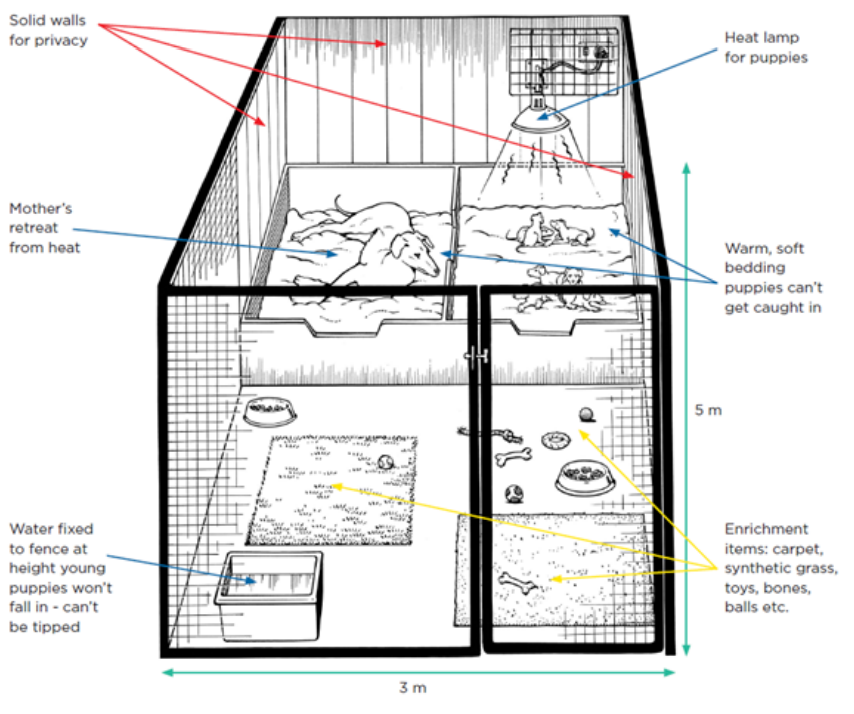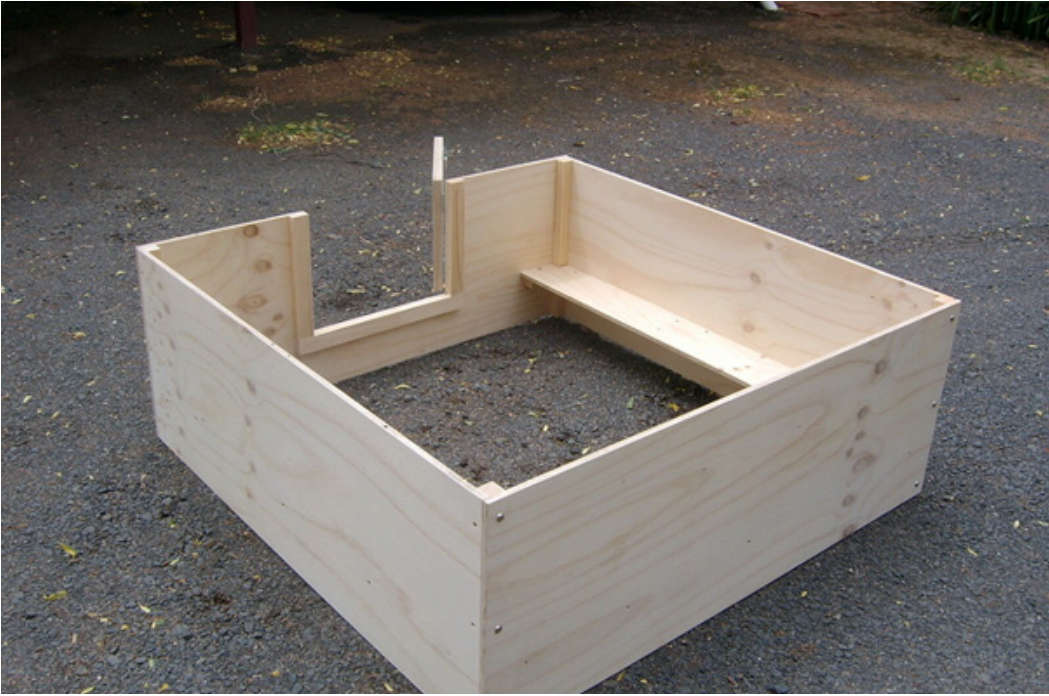Whelping Boxes
A dam is at her most vulnerable during whelping and puppies in the first few weeks of life need constant care and attention. Hence greyhound breeders often put a lot of thought into planning for the birth of a litter.
Most breeders use a whelping box for the dam and her litter for the first few weeks of life.
Location
A whelping box needs to be located somewhere that is warm, dry and quiet, but easy for the breeder to supervise. It also needs to be easily accessible with good lighting. Consider somewhere that is warm and private enough for a dam and her puppies.
Design
Whelping boxes need to have sides that are high enough to keep small puppies up to four weeks old in but low enough to allow the dam to get out. This will usually mean the walls need to be 50 - 60cms high. Some boxes have a small gate at the front which will allow puppies in and out, and also makes access for humans easier.
Whelping boxes should also have a rail which runs around the inside of the box, about 15 – 20 cms from the floor. The purpose of this ‘crush rail’ or ‘pigrail’ is to stop the dam rolling over on top of a young pup and crushing it against the wall.
Some whelping boxes do not have a base. If the whelping area has a tiled or cement floor a base may not be necessary (and the box will be lighter without one) as the floor is easy to clean. However, if your whelping box does not have a floor it is important to provide extra bedding to insulate the puppies from the cold floor.
Some whelping boxes have two parts – essentially, two boxes side by side with an opening between the two sides. This ‘whelping pen’ design allows the dam to retreat to one side while the pups explore the other box. This design has the advantage that it can accommodate the dam and her litter for longer, until the pups are a little older but not yet old enough to escape the box.

Size
A whelping box must be large enough to allow the dam to lie comfortably, and accommodate all the puppies for the first four weeks. Greyhounds tend to have large litters of six puppies or more, so require a large whelping box. For a single box, 1500mm (1.5 metres or 5 feet) by 1500mm is a minimum, and 1800mm (1.8 metres, or 6 feet) by 1800mm is preferred. A double box whelping pen might have two boxes of 1500mm by 1500mm.

Materials
Different materials have different advantages and disadvantages. Wood – usually pine - is the most commonly used material, and the easiest to work with if you are planning to build your own whelping box. Wood has the disadvantage that it can absorb fluids making it difficult to clean and disinfect and so more likely to harbour disease and pests. It is important to paint or varnish the wood to prevent this, but do any painting well ahead of the whelping to ensure there are no bad smells or fumes during whelping.
Other materials such as plastic, fibreglass or aluminium can also be used. These materials have the advantage that they are easier to clean and sterilise but are often more expensive.
Heating
Heating is particularly important for puppies. Young puppies cannot regulate their own body temperature for the first few weeks after being born, and chilling is a common cause of mortality in young pups. Hence it is critical that you ensure that the whelping box has adequate, reliable heating.
An ambient temperature of about 32 degrees Celsius is recommended for the first 4 days after whelping. This can be gradually reduced to a more normal temperature over the next 2 – 3 weeks as the pups grow.
A comfortable temperature for newborn pups is likely to be too hot for the dam, though. Consequently, it is advisable to heat only part of the whelping box so that the dam does not overheat.
Different breeders use different methods to provide heating. A heated lamp over one corner of the whelping box is a common method. A lamp has the advantage that it allows the dogs to regulate their own temperature by moving closer to or away from the lamp.
With a lamp, it is important to ensure that it is positioned high enough that no leads or wires are within reach and the dam will not bump into it.
Heated pads or mats may also be used, and some whelping boxes have a floor which provides for under-floor heating. The key thing with these methods is to ensure that there are no cords or wires available for dogs to chew on.
Bedding
Different materials can be used for lining the box and providing bedding for the occupants. Many breeders use newspaper or shredded paper with blankets on top for whelping. Paper has the advantage that it is cheap and easy to dispose of if it gets soiled during the whelping process. It can then be replaced with dry bedding such as towels or blankets. It is important to think carefully about the bedding you provide for the dam and puppies. Lots of deep, thick bedding material can be a risk for small puppies who may get trapped under heavy bedding. Bedding also needs to be changed and cleaned regularly, so it is advisable to choose materials that are easy to wash and dry.
DIY
Many people choose to build their own whelping box. There are lots of good plans and instructions available on the internet. If you are using plans from the internet, it is advisable to check with an experienced breeder or your veterinarian before starting work. You can also buy a whelping box - either new or second hand – or hire one. As many people breed only one or two litters, it is not hard to buy a whelping box second hand. If you are buying products second hand, it is most important to ensure that they are cleaned thoroughly (diluted bleach is preferred for this), rinsed and aired before use.
Water bowls
Very young puppies do not need water, as their hydration needs are met from lactation. However, the dam will need access to fresh clean water at all times and will drink increased amounts when lactating. Hence a water bowl will be needed within the whelping area. Choose a design that puppies cannot chew, tip over or fall into. Some breeders fix the water bowl to the wall of the pen. Puppies will also need access to water from the age of about 3 weeks, so you will need to ensure that they also have access to water as they start to wean.